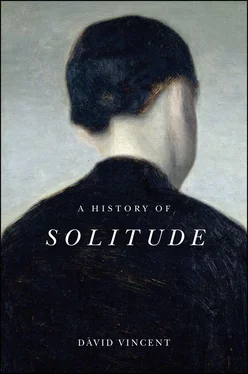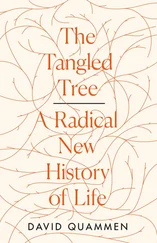It is evident then, that as I see nothing but what is far from being retir’d, in the forced Retreat of an Island, the Thoughts being in no Composure suitable to a retired Condition, no not for a great While; so I can affirm, that I enjoy much more Solitude in the Middle of the greatest Collection of Mankind in the World, I mean at London , while I am writing this, than ever I could say I enjoy’d in eight and twenty Years Confinement to a desolate Island. 104
It was an argument about what was necessary and also what was feasible. Crusoe’s creator had no doubt that abstracting himself at will from the complex networks in which he lived and worked was an entirely practical proposition. His hero insists that ‘all the Parts of a compleat Solitude are to be as effectually enjoy’d, if we please, and sufficient Grace assisting, even in the most populous Cities, among the Hurries of Conversation, and Gallantry of a Court, or the Noise and Business of a Camp, as in the Desarts of Arabia and Lybia , or in the desolate Life of an uninhabited Island’. 105
By its nature, abstracted solitude has left little record, but it may be argued that in the overcrowded domestic interiors in which most people lived for much of the time covered by this study, it was the principal means of achieving the benefits traditionally claimed for physical isolation. It required a degree of practised concentration, and could vary in time from a few snatched minutes of contemplation or day-dreaming to a prolonged immersion in a personal task or distraction. There was a frequent association with types of networked solitude, most obviously getting lost in a book whilst the noisy life of the household went on around the reader. In middle-class interiors it was visible in the ability of employing householders to consider themselves entirely alone whilst in the presence of toiling servants. Throughout the period it was influenced by technical change, and as Chapter 8will argue, it reached its apotheosis with the arrival of the texting smartphone.
Common to the differing responses to modernity and the varying categories of solitude were questions of class and gender. Late eighteenth- and early nineteenth-century writers on the subject, as on melancholy more generally, were in no doubt that their principal concern was with well-educated men. 106‘Close, and unremitted thinking’, as Thomas Arnold argued, was a leading cause of insanity. 107Only those with a mature, balanced mind were capable of withstanding the perils of isolation and returning to productive intercourse with society. Conversely, those spending excessive hours in their studies were especially vulnerable to the pathologies of solitude, whereas the bulk of the population were shielded from them by their intellectual limitations. As William Buchan’s Domestic Medicine of 1769 put it, ‘The perpetual thinker seldom enjoys either health or spirits; while the person who can hardly be said to think at all, seldom fails to enjoy both.’ 108Men who worked with their hands were unlikely to suffer from disorders of the mind. Thomas Trotter’s View of the Nervous Temperament of 1812 noted that ‘I do not find that the pitmen in the coal-mines in this district are liable to any particular diseases; when temperate in drinking, they commonly live to a great age.’ 109
In most of the contemporary commentary, women were excluded from the benefits of the solitary state. The early eighteenth-century poet Mary Chudleigh regarded it as a ‘masculine pleasure’ for which reason ‘ Solitude ought never to be our Choice, an active Life including in it much greater Perfection.’ 110There was a possibility of withdrawal ‘in our Studies, in our Gardens, and in the silent lonely Retirement of a shady Grove’, but ‘none can be thus happy in Solitude , unless they have an inward Purity of Mind, their Desires contracted, and their Passions absolutely under the Government of their Reason’. 111Zimmermann thought this display of virtues highly unlikely amongst women. Either they were simply too busy managing the affairs of the family ever to have the opportunity to enjoy their own company, or their particular exposure to the imaginative faculty rendered them incapable of withstanding its destructive effects. ‘Solitude is still more prolific of visionary insanity in the minds of women,’ he observed, ‘than in those of men; since the imaginations of the latter are in general less governed by an irritable sensibility and more restrained by stability of judgment.’ 112
People with time to spare were held to require a certain level of education to make use of their leisure. The seventeenth-century poet Abraham Cowley observed in his essay ‘Of Solitude’ that he ‘cannot much recommend Solitude to a man totally illiterate’. 113Those encountering what he termed ‘the little intervals of accidental Solitude, which frequently occurr in almost all conditions (except the very meanest of the people, who have business enough in the necessary provisions of life)’, needed access to books or some form of ‘Ingenious Art’ to fill the empty hours. 114It is possible to argue, however, that solitude has both an upper-case and a lower-case existence. There is an intertextual literary tradition, reviewed in Zimmermann’s treatise and revisited in prose and poetry throughout the modern period. And there is a tradition of commonplace practices which have been and remain of critical importance to men and women of every level of society and education as they seek to balance their lives and find space for themselves amidst the demands of company.
Cowley’s ‘little intervals of accidental Solitude’ were not the exclusive preserve of the privileged, whether male or female. For most of the population at the turn of the nineteenth century, even in urbanizing England, many of such opportunities as existed were to be found in the rural economy. In 1800, the labourer poet Robert Bloomfield wrote in The Farmer’s Boy of the young lad tending a field of growing wheat and in the course of his daily labour enjoying ‘his frequent intervals of lonely ease. … Whence solitude derives peculiar charms’. 115As Chapters 3and 5will explore, there were times in the working day when the demands of labour could be suspended, the more so before the imposition of factory-based time discipline. In the home there were again moments of escape, their incidence varying according to the numbers and ages of children. The density of company varied over the course of the day as men went out to labour and increasingly children left for school. And always, particularly but not only in rural areas, there were the gardens, lanes, and fields beyond the front door where it was possible for fleeting periods to be alone with yourself. 116
Upper- and lower-case categories of solitude have to be seen in relation to each other. There needs to be a focus on the exchange between the literary discourse and everyday attitudes and practices. In his classic study of the related subject of the pastoral ideal in American life, Leo Marx argues that ‘to appreciate the significance and power of our American fables it is necessary to understand the interplay between the literary imagination and what happens outside literature, in the general culture’. 117Over the period from 1800, there were a series of fierce debates on topics, for instance, such as solitary confinement, which will be examined in Chapter 4, where there was complex movement between high-level theoretical arguments, some of which went back to the monastic tradition with which Zimmermann was so preoccupied, and the actual and perceived experiences of common criminals. By the same measure, as Chapter 7argues, it is impossible to understand the emergence of the pathology of loneliness in a range of sociological, psychiatric and medical studies unless a clear view is kept of the basic features of demography, household structure and standards of living from the nineteenth century onwards. More generally, successive information revolutions, from the Penny Post to the internet, profoundly altered the sense of what solitude was and might be as a communicative experience.
Читать дальше












